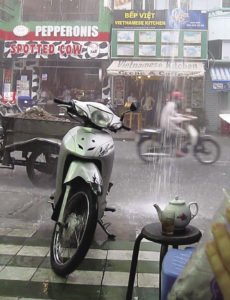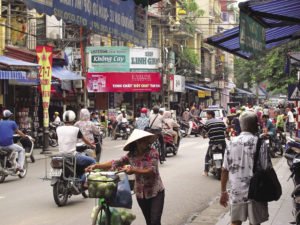A xe ôm driver naps in Hanoi. | HOUSETOLAOS.COM
By Micaella Penning
Amidst the whine and whir of the Hanoi traffic, small motorbikes carry propane tanks, carpet rolls, hundred-pound rice bags, cages stuffed with ducks and chickens—sometimes alive, sometimes dead—suitcases, bushels of baguettes, aquariums, ladders in an upright position, logs, and wooden crates of toilet paper rolls, five feet tall and wide. Entire families cling to single bikes; toddlers often left to fend for themselves while grabbing the backs of their parent’s shirt. Few children wear helmets; the law requiring their use is enforced only on adults.
Many drivers wear facemasks to guard against pollution, giving an austerity to their faces, with only the eyes visible between the helmet, mask and jacket. In the city, the sun dissipated into a sickly blue-gray cast. Breathing the thick fumes added to the feeling of sluggish nausea caused by heat and humidity. But drivers seemed relaxed and nonchalant, as they zipped and zoomed in a viscous mob, honking their horns, weaving around sauntering pedestrians and idling trucks, equally content in the right lane, the left lane, the middle, or the sidewalk. Drivers shouted into cell phones above the roar, and lighted up cigarettes at stoplights. I saw one man idly resting his foot on another bike’s muffler as they careened by.

Crossing the street on foot was a nightmare—it felt as if all of two-wheeled Hanoi was barreling down on me. Several times my toes came within inches of bearing rubber tread indentations. My guidebook had said not to waver when crossing the street, and not to run, stop, or show fear. At first, this felt impossible. I sprinted and stopped, wobbled and waved, quivered and bounced, as if walking on glowing coals. Eventually, I became calmer, trying to emulate the placid ambling of Hanoians. I always tried to wait until other people were crossing, sidling to the group’s edge furthest from oncoming traffic, selfishly imagining them as human shields. But only my nerves were scathed; I never saw anything resembling a run-in, let alone an accident.
It wasn’t only the road that was clogged with motorbikes: the sidewalks resembled giant, skinny strips of parking lot or dealership. In areas, their thickness sent me back on the fringes of the street, as I anxiously hopped back and forth between curb and road, as space allowed. Noodle-sellers stirred steel cauldrons of steaming broth among tailpipes, mufflers and wheels, clad in nón lá, the quotidian, conical-shaped leaf hat. The hat has ancient origins—even people carved onto bronze relics three millennia ago wore them; long before appearing scattered amidst parked motorbikes.
“Lets take a xe ôm instead of a taxi!” my friend Diana excitedly declared as we left the cool, air-conditioned stillness of our guesthouse in Hanoi’s old quarter. “I took them all the time when I lived in Rwanda,” she said.
Nervous but ready for something new, I agreed. A xe ôm is a motorcycle “taxi,” translated as hug taxi. On our first ride, I did just that, as both Diana and I squished on behind the driver. My fingers probably left marks through his shirt, as my knuckles whitened and I clamped on in fear. He’d given us both helmets before we got on. I held mine in my hands and stared at it for a few moments, remembering other sage advice from my guidebook: wear a hat beneath the helmets—they often have lice. I had no hat. I imagined my head encrusted with blood-sucking insects, their eggs glued onto hairs near my scalp. Next, I imagined my brain scattered across the street.
I quickly put the helmet on—my head never got itchy.
But Diana was much slower to decide. She stared at me while I put mine on, wide-eyed, mouth curled in sour perplexity. Finally, she strapped it beneath her chin and climbed on to the hug taxi. The driver cranked on the bike and we buzzed out into the mayhem, quickly becoming engulfed in the surrounding sea of motorbikes and their masked drivers.
The process of finding a xe ôm remained obscure to us throughout our time in Vietnam. Xe ôms weren’t marked or designated in any way. Differentiating between them and residents on their own missions often felt impossible. One clue was the proficient napping of xe ôm drivers. They tended to congregate at busy street corners, where they’d park and drape themselves in a supine position on their bikes to nap. Some rested their heads on the handlebars; while others faced towards the front, their knees draped down the bike, head on the back edge of the seat. Proactive drivers sometimes approached us, asking where we wanted to go, but we tried to hire those who were quieter. As soon as we started speaking to a driver, a band of others would converge around us, listening and talking amongst themselves. If the person we’d chosen spoke no English, another would voluntarily translate. Or we’d open our crumpled map and point. Usually in our disorientation we weren’t sure if we were on our way to the place we wanted or not. We only knew when we arrived. If we were heading back to our guesthouse, I was always relieved to the see the flashing neon sign advertising a national cell phone company that marked a nearby street corner. Often I felt helpless in my ignorance. Ending up on the back of an illegitimate xe ôm seemed inevitable.
Eventually, we felt safest navigating this way. In Ho Chi Minh City, a taxi driver demanded we pay ten times what the meter read. We tried to leave, but he locked us in. We had no escape. With shaking hands I fumbled through my bag for the money. Only after he counted it did he unlock the doors. At least with a motorcycle, we could “jump off” if things got bad. But it never did.

I had expected only terror when we rode out into the melee of wheels, rubber, and exhaust fumes that first afternoon in Hanoi. My long legs meant that my knees were the farthest point on either side of the bike; I clenched them tightly in against the driver, fearing they would scrape against car doors, delivery trucks, lamp posts, other motorbikes, and pedestrians.
Yet suddenly, everything felt smooth, flowing. Our driver gracefully steering around potholes and bumps—the streets seeming to float past, as though we were now a school of fish, acting in concert with the thousands of other motorists. The hum of cheap, internal combustion engines buzzed like a chorus of cicadas.
Stopping at red lights, the air sagged with heat and exhaust. Then the light would turn green, and I felt like I was on the starting grid of a Formula One race, as hundreds of engines revved and raced away, the air shimmering in the heat, smelling of fresh rubber and fuel. Movement eased the temperature, and soon my skin felt bearable again as we whizzed across roads, down alleys, and through intersections, always leaning towards the pavement around corners.
Dust, dirt and bugs blew against my face. But I felt like I was flying, the disorder melding into blissful tranquility. Fluidity fleetingly enveloped the city. We reached our destination and climbed off, stumbling back into Hanoi’s interminable expanse of strident struggle.






